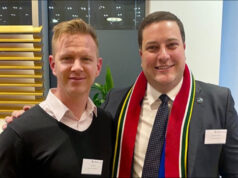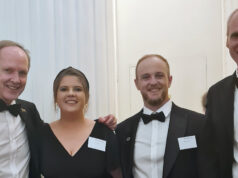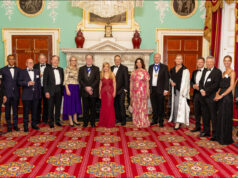John Battersby at the Tutu Peace Summit – Regent’s University 11th April 2019
“I see only one hope for our country, and that is when white men and black men…desiring only the good for their country, come together to work for it. I have one great fear in my heart, that one day when they are turned to loving, they will find that we are turned to hating….”
The prophetic words of Theophilus Msimangu, a Zulu priest, in Alan Paton’s iconic novel Cry the Beloved Country, still the best-selling book – other than the Bible – in South African literary history.
At the time of Paton’s death in 1988 aged 85, it had sold more than 15 million copies in 20 countries since its publication in February 1948, the year the National Party came to power in South Africa. Long Walk to Freedom, Nelson Mandela’s autobiography is said to have clocked up sales of 15 million worldwide since its publication in 1994.
Paton’s work has twice been adapted for the cinema (1951 when apartheid was just getting into its stride and 1996 the year South Africa adopted its first non-racial constitution following the first democracy elections in 1994.) And in 1949 it was adapted as a musical on Broadway based on the Book Lost in the Stars by American author Maxwell Anderson with music by German émigré Kurt Weil.
Paton was looking at South Africa as a liberal and a Christian of British origin who had made South Africa his home.
What is most remarkable about Paton’s towering literary and moral achievement is how it resounds with the South Africa of today and what has happened in the seven decades since he wrote the book making allowance for his reference to men rather than men and women and one or two other dated turns of phrase.
The context of the quote about hate is a discussion between Kumalo and Msimangu about the corrupting influence of power and whether white men are more corruptible than black men.
They bemoan the fact that it is this corruption that is restraining South Africa from progressing from and they share their dreams of black/white co-operation to enable the country to realise its true potential. Sound familiar? That was written 70 years ago before apartheid had made it into the Oxford dictionary.
Other events of note occurred in 1948.
Zionism triumphed after a long struggle in Palestine and the state of Israel was created. India gained its independence after a long non-violent campaign against British imperialism. And the National Health System was established in Britain. To mention a few. Apartheid, the clash between Zionism and the Arab world and the struggle against British colonialism all led to a lot of hate and violence.
Major restructuring took place in all three conflict situations; India got its independence; South Africa following racially flawed independence in 1910 and departing the Commonwealth in 1960 had democracy elections in 1994; and Israel and the Palestinians are still slugging it out after countless failed peace attempts.
My first three years as a journalist in South Africa in the late 1970’s were spent inter alia covering the systematic destruction of the so-called coloured community of District Six at the foot of Table Mountain under apartheid’s draconian Group Areas Act which imposed racially separated neighbourhoods and the Slum Clearance Act which provided a flimsy excuse for ethnic cleansing.
A vibrant maitrix of traders, professionals, gangs and street sellers waited for a knock on the door – would arrive home to find a notice attached to their door giving them 30 days to vacate their homes.
This continued relentlessly until the bulldozers had flattened the entire neighborhood and everyone of the last 66 000 were banished to the wind-swept and barren wastelands of the Cape Flats which in turn gave rise to far more violent and gangs and all the social ills associated with displacement. All that remained was a pile of rubble and a scar on the mountainside still visible today.
How do you not turn to hate when such injustice is meted out by a soulless and vicious white minority regime?
This systematic ethnic cleansing and social engineering amounted to a genocide of the soul.
When the bulldozers turned on the black shanty towns of Modderdam, Unibel and Werkgenot I would search for a flicker of humanity in the eyes of the white public works employees as they ripped apart corrugated iron houses which were home to tens of thousands of people.
As a South African correspondent in the Middle East I saw another brand of hatred with much deeper roots. How can a conscripted 18-year-old Israeli soldier at a checkpoint between Jerusalem and the West Bank ever hope to find the humanity in a Palestinian when his first interaction with them is lining him or her up in the sights of his or her automatic weapon.
When I was posted there in the mid-1990’s I was not prepared for the reality. It was not popular to compare Israel with apartheid South Africa but I could not escape equating the processes of dehumanisation which enabled Israelis to treat Palestinians as lesser human beings to justify a series of actions which they would never have inflicted on their own people.
The intersection of identity, fear and hate is a toxic mix which is very difficult to roll back once it has passed the point of no-return as it did in the Israeli/Palestinian conflict a long time ago and as can be seen today.
In Asia it can be seen in the treatment of the million Rohingya’s driven out of the Rakhine State in Myanmar; in the fundamentalism of ISIS and persecution of the Yazidis; the Tutsi’s fleeing from the Hutu’s; the Falun Gong, the Uighurs and the Tibetans in China; the Bahai in Iran; the Kurds in Turkey, Syria and Iraq; and one could go on and on.
Or we can reach back into recent history to the concentration camps of Nazi Germany or the gulag’s of Stalin’s Russia or the cultural revolution in China. Or the killing fields in Cambodia. The Protestants and Catholics in northern Ireland; the Crusaders; the era of slavery in which the UK was a major player and financial beneficiary; the US in Vietnam and Guantanamo Bay. There is no shortage of anecdotal evidence when it comes to man’s inhumanity to man and indeed to woman.
There are too many examples in history of how differentiation and stereotyping has led to hatred and violence.
What do all these have in common?
Human beings need very little encouragement to be really nasty to each other as the experiment with the brown eyes and the blue eyes so chillingly illustrates.
There is a recurring pattern of exclusion and denial leading to alienation, resentment and eventually fear and violent conflict which exacerbates racial or ethnic tension and, if unchecked, can lead to a race war where interaction is dominated by stereotypes, dehumanisation of “the other” and xenophobia.
Although there are still some horrific racial attacks of white on black – and ongoing attacks on white farmers and small-holders – and no shortage of hate speak from the likes of the Economic Freedom Fighters and the lobby group Black First, Land First – the fundamental dynamic in South Africa of racial tension is driven by economic inequality and opportunism rather than racial hatred per se.
The relative atmosphere of hope and reconciliation under Mandela which continued to some extent into the Thabo Mbeki era rapidly unravelled during the nine-year administration of Jacob Zuma characterised by patronage and corruption, a loss of moral direction and a widening of the gap between rich and poor.
President Cyril Ramaphosa is doing everything in his power to revive the Mandela vision and values after almost a decade of disastrous rule which took the country to the very edge of failed state status. There is hope again but the restoration process will be long and hard.
President Ramaphosa has a tough journey ahead but has made significant progress in rebuilding institutions, reviving fair play and the rule of law.
Today the Archbishop’s powerful vision of the Rainbow nation – and the Mandela vision – are under severe stress.
In South Africa xenophobia is never far below the surface putting a heavy burden on leadership to set an example of tolerance and inclusion rather than reinforcing stereotypes.
The solution to hatred is invariably to highlight our primary identity as humans and from that base strive to understand the point-of-view of “the other” and reach a compromise based on inclusion, understanding and ongoing communication to prevent a reversion to the stays quo ante. It calls on us to transcend our basest instincts.
Good education and strong and sound leadership can go a long way to achieving these goals.
The Archbishop’s commitment to the values of Ubuntu – I am because you are – is the way he lives his life. He is a living example that what really matters is not what you do in life but the way that you do it.
Nowhere was his commitment to the values of Ubuntu clearer than in the Truth and Reconciliation Commission where his focus was always to humanise both the perpetrators and victims by bringing perpetrators and victims together and acknowledging perpetrators as human beings and thus assisting them to take responsibility for their often terrible actions.
Nelson Mandela, despite having to meet the challenges of political power, was always clear on the principles of acknowledgement of the humanity of “the other” and the principle of inclusivity.
These qualities of true leadership were crucial to the – at times seemingly impossible – achievement of a negotiated settlement in South Africa.
One does not need to be a psychologist or academic expert to see that hatred is inevitably preceded by an act of exclusion – or perceived exclusion – followed by alienation, resentment, hate, fear and eventually violent conflict.
But there are no quick fixes when it comes to removing the underlying causes of hatred.
Archbishop Tutu insisted during the TRC process that reconciliation could come only with the perpetrator confronting the full horror of his or her actions and the victim experiencing deep forgiveness. Only in such a profound exchange could there be redemption and release from hate and all the pain that accompanies it.
So the question becomes: how do we deal with these challenges in a post-conflict situation still contaminated by residual inequality as in South Africa.
Here the values of inclusivity, magnanimity, forgiveness and steadfastness become vital.
The Tutu Foundation UK is doing a great job initiated by the late Paul Randolph in reaching out to marginalised youth in disadvantaged London Boroughs to build bridges and break down barriers between the youth and the police. This initiative has gained a new urgency with the alarming proliferation of knife crime in London.
Baroness Doreen Lawrence, mother of Stephen Lawrence, whose was tragically murdered by police 20 years ago, has turned adversity into triumph with the Stephen Lawrence Foundation and the launch next month of the Stephen Lawrence Research Centre. Baroness Lawrence recently visited South Africa in her role as Chancellor of De Montfort University.
The life lived by Nelson Mandela was an exemplary demonstration of Ubuntu. And the Archbishop is a living example of Ubuntu.
In his 1999 book, No Future Without Forgiveness, Archbishop Tutu elaborates on the notion of Ubuntu which is so close to his inclusive heart.
“A person with Ubuntu is open and available to others, affirming of others, does not feel threatened that others are able and good, for he or she has a proper re-assurance that comes from knowing that he or she belongs in a greater whole and is diminished when others are humiliated or diminished, when others are tortured or oppressed.”
These values need to be engendered in our youth and should permeate the education system at all levels.
And they are the qualities not only embraced but lived by Archbishop Desmond Tutu to inspire the youth of today to make for better world leaders tomorrow.
- John Battersby is a Global Peace Ambassador for the Tutu Foundation UK, chair of trustees at the Canon Collins Educational and Legal Assistance Trust and a Director of the South African Chamber of Commerce. This is an extract of a speech at the 4th annual Desmond Tutu Peace Summit held at Regents University in London this week. The Theme was Hate: Causes, Consequences and Cures.









